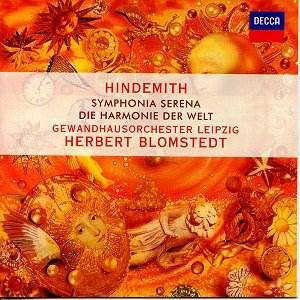HINDEMITH
Symphonies: Sinfonia Serena & Der Harmonie der Welt
 Gewandhausorchester
Leipzig/Blomstedt
Gewandhausorchester
Leipzig/Blomstedt
 Decca 458 899-2
67
mins.
Decca 458 899-2
67
mins.
Crotchet
Amazon UK Amazon USA

Less familiar than Hindemith's symphony derived from his opera Mathis
der Maler, which has held a tenuous place in the 20th. C. orchestral
repertoire, these two symphonies date from 1946 and 1951 respectively, the
latter reworked from material for an opera of the same name not completed
until 1957, and almost forgotten.
I heard Hindemith (1895-1963) introduce his Serene Symphony at a BBC concert,
at The People's Palace in East London, shortly before his unexpected death,
conducting in his undemonstrative, business-like manner, and have welcomed
this opportunity to renew its acquaintance. Translated as Cheerful Symphony
in the liner notes, the serene beginning of the earlier of the two leads
through to a rather grandiose, portentous conclusion of the first movement.
Its second movement, for winds alone, is a paraphrase of a military march
by Beethoven, building to a boisterous, noisy ending. The third,
Colloquy, for strings alone is delicate, with solo cadenzas and two
contrasted passages brought together in contrapuntal combination, Hindemith's
forte. The finale, for full orchestra, returns to the good-natured mood of
the opening, builds up once more with contrapuntal density and brings back
the first movement's main theme to round off the whole work. This well tried
formal scheme for the four movements is to be found also in Vaughan Williams's
8th and Nielsen's 6th symphonies; the three would make an excellent concert
programme of just the right length.
The later work has a programme based upon the life of the astronomer Kepler,
who endowed the motion of the planets with musical proportions, and his search
for 'the harmony which undoubtedly rules the Universe'. Musica instrumentalis
has wide contrasts; Musica Humana conjoins separate materials
(as in the slow movement of the other symphony here) and Musica Mundana,
the third of its three movements, is a fugato leading into a long, heavily
orchestrated passacaglia, with a grandiose peroration, which I found more
academic than inspiring.
These symphonies are well recorded, satisfactory accounts of well-crafted
music which, fifty years on, no longer seems to be part of the main stream.
Purchasing decisions will therefore depend upon the music itself. It is hard
now to recall that Hindemith's personal harmonic language, systematised in
his writings, was at one time seen as innovative and a rival to Schoenberg's
12-tone system, so conservative does his later music now sound.
Reviewer
Peter Grahame Woolf

